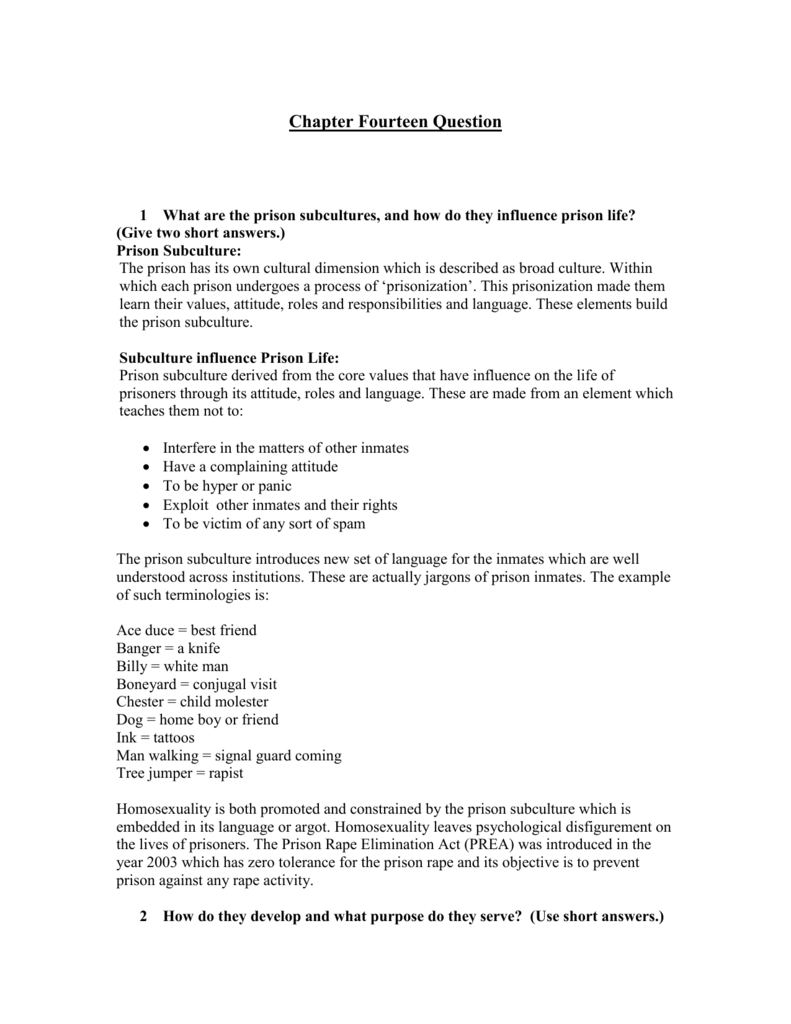Clemmer postulated that the variables affecting degree of prisonization are: socialization during pre-penal life, continuation of positive relationships outside of the penitentiary, affiliation with inmate groups with inmate groups, placement into small groups that are separate from the general population, and the duration of the sentence. Donald Clemmer Biography; Prisonization Prison Experience; Prisonization as the inculcation of a convict culture was defined by identification with primary groups in prison, the use of prison slang and argot, the adoption of specified rituals and a hostility to prison authority in contrast to inmate solidarity and was asserted by Clemmer to. GRUNINGER, PRISONIZATION IN FIVE COUN-TRIES: TYPE OF PRISON AND INMATE CHARACTER-ISTICS (1975) (unpublished manuscript at University of Iowa); C. Schrag, Social Types in a Prison Community 1944) (unpublished M.A. Thesis at University of Washington). CLEMMER (1940), supra note 2; R.
Donald Clemmer Prisonization Trump
 Cite this Item
Cite this Item Copy Citation
Donald Clemmer Prisonization Of Children
Export Citation
With a personal account, you can read up to 100 articles each month for free.
Already have an account? Log in
Monthly Plan
- Access everything in the JPASS collection
- Read the full-text of every article
- Download up to 10 article PDFs to save and keep
Yearly Plan
- Access everything in the JPASS collection
- Read the full-text of every article
- Download up to 120 article PDFs to save and keep
Purchase a PDF
Purchase this issue for $40.00 USD. Go to Table of Contents.

How does it work?
Donald Clemmer Prisonization Case
- Select a purchase option.
- Check out using a credit card or bank account with PayPal.
- Read your article online and download the PDF from your email or your account.
Donald Clemmer Prisonization Of Veterans

- Access supplemental materials and multimedia.
- Unlimited access to purchased articles.
- Ability to save and export citations.
- Custom alerts when new content is added.

Twenty years ago the sociologist Donald Clemmer introduced the concept of prisonization to account for the changes inmates undergo during periods of confinement. This paper reexamines the concept of prisonization and provides an empirical test of the process Clemmer described. Because of Clemmer's concern with the process of induction, little attention has been paid to changes inmates may exhibit as they approach the time of release. Evidence from a western state reformatory is consistent with Clemmer's analysis when length of time served in prison is taken as the relevant time variable. When inmates are classified into phases of their institutional career, however, there is evidence of a recovery process and a shedding of the prison culture that operates prior to parole. The evidence suggests a reformulation of the effects of imprisonment on inmates and poses further problems relevant to other total institutions.
The official flagship journal of the American Sociological Association (ASA), American Sociological Review (ASR) publishes works of interest to the discipline in general, new theoretical developments, results of research that advance our understanding of fundamental social processes, and important methodological innovations. All areas of sociology are welcome. Emphasis is on exceptional quality and general interest. Published bi-monthly in February, April, June, August, October, and December. Information about subscriptions, article submissions, and advertising rates: http://www.asanet.org/journals/asr/

American Sociological Association Mission Statement: Serving Sociologists in Their Work Advancing Sociology as a Science and Profession Promoting the Contributions and Use of Sociology to Society The American Sociological Association (ASA), founded in 1905, is a non-profit membership association dedicated to advancing sociology as a scientific discipline and profession serving the public good. With over 13,200 members, ASA encompasses sociologists who are faculty members at colleges and universities, researchers, practitioners, and students. About 20 percent of the members work in government, business, or non-profit organizations.As the national organization for sociologists, the American Sociological Association, through its Executive Office, is well positioned to provide a unique set of services to its members and to promote the vitality, visibility, and diversity of the discipline. Working at the national and international levels, the Association aims to articulate policy and impleme nt programs likely to have the broadest possible impact for sociology now and in the future.
This item is part of a JSTOR Collection.
For terms and use, please refer to our Terms and Conditions
American Sociological Review © 1961 American Sociological Association
Request Permissions
Shanequa Ricketts
John Jay College
CRJ 425
Prof. Cheloukhine
Summer 2015
Abstract
Prisonization is a concept first introduced in 1940 by Clemmer. He defined it as the process of assimilation in prisons, where new inmates take on a less or greater degree of the customs, folkways, and the general culture in a penitentiary. Prisonization can be described in similar terms to those used by sociologists in capturing the processes of assimilation and socialization of communities at large. In the same manner people are assimilated to the customs and norms of a society, inmates must also assimilate themselves into the self-contained community they find in prison. They need to re-adjust from their normal lives and learn the new norms and rules, as well as the implied expected patterns of behavior since they are discordant from the societal values of a free world. Also referred to as the “inmate code”, this is the kind of behavior that is considered to be unacceptable in the free world but is encouraged, and rewarded within the prison walls.
In the United States of America, the jail culture has been referred to as out of control and unruly in most cases. There have been instances of gang control of prison activities through member inmates. There are also patterns of assimilation in the jails, especially bearing in mind that most of the people incarcerated are from different cultures most and countries. In essence, the